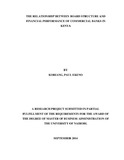| dc.description.abstract | There is no specific optimal board structure that applies to all banks; every board
considers whether its size, diversity and demographics make it effective. The objective of
the study was to investigate the relationship between board structure and financial
performance of commercial banks in Kenya. Data was collected from the 42 commercial
banks which were operational in Kenya for three years - 2011, 2012 and 2013. ROA was
used in this study to measure financial performance. Data was collected in relation to
various elements of board structure, specifically: board size, director independence, board
meetings, compensation committee, nomination committee, audit committee, gender
diversity and foreign directors. Control variables used in this study were: bank age,
ownership structure and peer group. Data was analyzed using descriptive and inferential
statistics.
Correlation analysis shows strong positive relationship between ROA and age of a bank
and bank size – CBK has classified banks as either small or medium or large size. The
study found existence of weak positive relationship between ROA and size of the board,
existence of a nomination committee and the proportion of female directors. The study
found negligible relationship between ROA and the number of board meetings, existence
of a compensation committee, the size of the audit committee, the proportion of foreign
directors and bank ownership structure. The analyses showed that board structure
elements account for 45% of the financial performance of commercial banks. Of all the
variables under study, compensation committee, nomination committee, audit committee
size, proportion of foreign directors and bank's peer group were found to be significant
predictors of bank financial performance. The other variables – board size, director
independence, board meetings, audit committee independence, audit committee meetings,
gender diversity, bank age and ownership structure – were found to be insignificant
predictors of ROA.
This study makes the following recommendations: policy makers should consider making
it mandatory for banks to establish nomination committees; policy makers should set up
higher capital requirements for banks; boards should consider establishing ad hoc, rather
than permanent, compensation committees; boards should ensure they have lean sizes of
audit committees; and foreign owned banks should consider recruiting more local than
foreign directors. | en_US |

